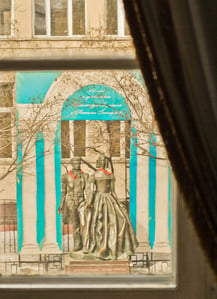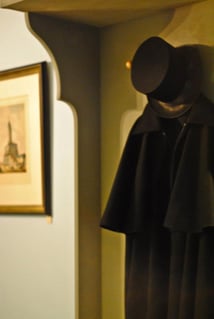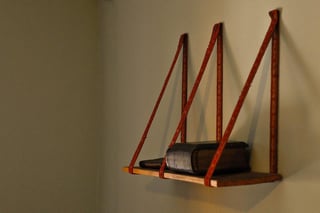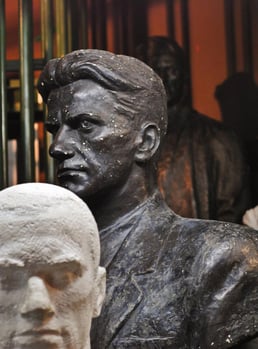If you’re planning a trip to Moscow, Russia and are interested in visiting authors’ homes, you’re in great luck. We only had a handful of days to spend exploring the many literary haunts and homes of some of Russia’s greatest writers, so we packed in as much as we could. While visitors to Russia often think of St. Petersburg as the place to go to visit the homes of Fyodor Dostoevsky and Vladimir Nabokov, we can’t recommend a trip to Moscow enough. In addition to the magnificence of Red Square and St. Basil’s Cathedral, where else in the world can you pack in visits to the former addresses of six of the world’s greatest writers?
Alexander Pushkin’s Apartment
 We’ll start with famed Russian poet, playwright, and novelist Alexander Pushkin. While there’s also a Pushkin Museum and Memorial Apartment in St. Petersburg, the writer only lived in that residence for about a year before being killed in a duel in 1837. Pushkin was born in Moscow in 1799. It was in this apartment on the Arbat, now the A.S. Pushkin Memorial Apartment museum, where the writer lived first with wife, Natalia Goncharova, during his rise to literary fame. From several of the apartment rooms, visitors can look out onto the Arbat, the oldest pedestrian street in the city.
We’ll start with famed Russian poet, playwright, and novelist Alexander Pushkin. While there’s also a Pushkin Museum and Memorial Apartment in St. Petersburg, the writer only lived in that residence for about a year before being killed in a duel in 1837. Pushkin was born in Moscow in 1799. It was in this apartment on the Arbat, now the A.S. Pushkin Memorial Apartment museum, where the writer lived first with wife, Natalia Goncharova, during his rise to literary fame. From several of the apartment rooms, visitors can look out onto the Arbat, the oldest pedestrian street in the city.
Pushkin is best known for works such as Boris Godunov (1825), The Tales of the Late Ivan Petrovich Belkin (1831), and Eugene Onegin (1833).
Nikolai Gogol’s Home
 Very near the Arbat on Nikitsky Boulevard, your next stop might as well be to the home of Nikolai Gogol. Visitors to the museum enter into the front room with the fireplace, a spot now famous (or infamous) as the location in which Gogol burned his own Dead Souls manuscript.
Very near the Arbat on Nikitsky Boulevard, your next stop might as well be to the home of Nikolai Gogol. Visitors to the museum enter into the front room with the fireplace, a spot now famous (or infamous) as the location in which Gogol burned his own Dead Souls manuscript.
The Gogol Memorial Museum is where the writer spent the final four years of his life. It’s also where Gogol burned his manuscripts, as we mentioned, and he actually died in this house in the winter of 1852. Gogol was born in a region of the Ukraine in 1809. Gogol is well-known for his works of drama and fiction, such as his play The Gamblers (1836), his short story “The Overcoat” (1842), and his picaresque novel Dead Souls (1842).
Leo Tolstoy’s Winter House
 Leo Tolstoy had multiple homes in Russia, and his estate Yasnaya Polyana is perhaps the best-known of the now-museums in which Tolstoy once lived and wrote. While Yasnaya Polyana is about 200 kilometers south of the capital city and thus a bit difficult to reach during the winter, the novelist’s house in Moscow remains a much-visited site for lovers of nineteenth-century Russian literature. On the exterior, the house is a shade of orange—a seemingly odd choice for a wood-frame house. Inside, visitors can see a bearskin rug beneath Tolstoy’s grand piano and a chess board set ready for play. The house also boasts unique hanging bookshelves throughout the space, housing some of the 22,000 books that Tolstoy owned during his lifetime.
Leo Tolstoy had multiple homes in Russia, and his estate Yasnaya Polyana is perhaps the best-known of the now-museums in which Tolstoy once lived and wrote. While Yasnaya Polyana is about 200 kilometers south of the capital city and thus a bit difficult to reach during the winter, the novelist’s house in Moscow remains a much-visited site for lovers of nineteenth-century Russian literature. On the exterior, the house is a shade of orange—a seemingly odd choice for a wood-frame house. Inside, visitors can see a bearskin rug beneath Tolstoy’s grand piano and a chess board set ready for play. The house also boasts unique hanging bookshelves throughout the space, housing some of the 22,000 books that Tolstoy owned during his lifetime.
Tolstoy wrote his most famous novels, War and Peace (1869) and Anna Karenina (1877), at Yasnaya Polyana, but he wrote many of his other short stories and novellas at his desk in the country's capital city.
Andrei Bely’s Apartment
Also located on the Arbat but visited less frequently than Pushkin’s apartment, Andrei Bely’s apartment has also been converted into a memorial museum and is open to visitors. Bely is perhaps the least known of the writers in this article, but his modernist masterpiece, Petersburg (1913), is among our favorites of early twentieth-century fiction. The plot of the novel follows a young Russian revolutionary who, literally, is set to plant a ticking time bomb in order to assassinate his own father, an official within the Czar’s regime.
The walls of the apartment at 55 Arbat are covered in mathematical drawings rendered in colored pencil, created by the writer himself. For those in the know, Andrei Bely was actually a pen name for Boris Nikolaevich Bugaev.
Vladimir Mayakovsky’s Home
 If you visit Moscow and travel to Krasnaya Presnya street, you can visit the home of the Russian poet and artist Vladimir Mayakovsky. Designed in part by his daughter, the museum features several winding floors that house Mayakovsky’s photographs, manuscripts, and other objects that he owned during his lifetime.
If you visit Moscow and travel to Krasnaya Presnya street, you can visit the home of the Russian poet and artist Vladimir Mayakovsky. Designed in part by his daughter, the museum features several winding floors that house Mayakovsky’s photographs, manuscripts, and other objects that he owned during his lifetime.
Mayakovsky is perhaps best known for the role his poetry played in Bolshevik activism in the early part of the twentieth century. He committed suicide in 1930 in the apartment that, for a number of years, has been a museum dedicated to the writer. Currently, the museum is closed to visitors as it allegedly undergoes renovations. We’ll need to anxiously follow the news on this space.
Mikhail Bulgakov’s Apartment
Last but not least, you cannot visit the capital of Russia without a stop at the former apartment of Mikhail Bulgakov. On your way to the Bulgakov House, which is now an independent theatrical space with a few items on display that once belonged to the novelist, you should stop by Patriarch’s Ponds, where the opening of Bulgakov’s glorious novel The Master and Margarita (1928-1940) is set. Parts of the novel actually take place in the writer’s apartment, where you can now see a statute out front depicting two of the central characters in the posthumously published novel. There’s also a small bookstore inside in which visitors can purchase items connected to The Master and Margarita, as well as Russian-language editions of the book.
If you get a chance to visit Russia's capital, you can’t go wrong with visits to any or all of the homes of the writers we’ve mentioned. In the meantime, if you’d like to travel to this city through works of Russian literature, the texts of these writers are available in English translation and are waiting for you to purchase them.









